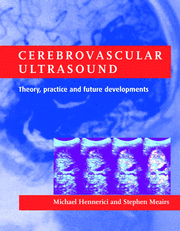Book contents
- Frontmatter
- Dedication
- Contents
- List of contributors
- Preface
- PART I ULTRASOUND PHYSICS, TECHNOLOGY AND HEMODYNAMICS
- PART II CLINICAL CEREBROVASCULAR ULTRASOUND
- (i) Atherosclerosis: pathogenesis, early assessment and follow-up with ultrasound
- (ii) Extracranial cerebrovascular applications
- (iii) Intracranial cerebrovascular applications
- 18 Transcranial Doppler ultrasonography and vasospasm after subarachnoid hemorrhage
- 19 Intracranial cerebral artery stenosis and occlusion
- 20 Arteriovenous malformations
- 21 High intensity transient signals
- 22 Transcranial Doppler monitoring during carotid endarterectomy
- 23 Cerebral vasoreactivity
- 24 Intracranial venous diseases: the role of ultrasound
- PART III NEW AND FUTURE DEVELOPMENTS
- Index
19 - Intracranial cerebral artery stenosis and occlusion
from (iii) - Intracranial cerebrovascular applications
Published online by Cambridge University Press: 05 July 2014
- Frontmatter
- Dedication
- Contents
- List of contributors
- Preface
- PART I ULTRASOUND PHYSICS, TECHNOLOGY AND HEMODYNAMICS
- PART II CLINICAL CEREBROVASCULAR ULTRASOUND
- (i) Atherosclerosis: pathogenesis, early assessment and follow-up with ultrasound
- (ii) Extracranial cerebrovascular applications
- (iii) Intracranial cerebrovascular applications
- 18 Transcranial Doppler ultrasonography and vasospasm after subarachnoid hemorrhage
- 19 Intracranial cerebral artery stenosis and occlusion
- 20 Arteriovenous malformations
- 21 High intensity transient signals
- 22 Transcranial Doppler monitoring during carotid endarterectomy
- 23 Cerebral vasoreactivity
- 24 Intracranial venous diseases: the role of ultrasound
- PART III NEW AND FUTURE DEVELOPMENTS
- Index
Summary
History of transcranial ultrasound
Leksell (1954) introduced echoencephalography for the evaluation of the position of midline and paramedian structures. Three decades later Aaslid et al. (1982) added transcranial Doppler sonography (TCD) for the study of cerebral hemodynamics. In the late 1980s transcranial Bmode sonography (Berland et al., 1988; Furuhata, 1989; Schönig et al., 1989) and frequency-based transcranial colour-coded duplex sonography (TCCS) (Bogdahn et al., 1990) were introduced. The most recent developments are power-based (Baumgartner et al., 1996; Griewing et al., 1996), contrast-enhanced (Baumgartner et al., 1997; Bogdahn et al., 1993; Görtler et al., 1998; Nabavi et al., 1998; Otis et al., 1995), and three-dimensional (Delcker & Turowski, 1997a, b; Delcker et al., 1997) TCCS.
Principles of transcranial ultrasound
Transcranial ultrasound studies are performed with low frequency transducers. The ultrasound probes in TCD devices emit with 2 or 1 MHz, whereas TCCS machines use frequencies up to 3.6 MHz. Both TCD and TCCS provide the measurement of velocities in defined depths and sample volumes. Colour Doppler imaging relies in the frequency based mode on the mean frequency shift of the Doppler signal, which reflects the mean velocity of moving particles. Power-based colour Doppler imaging visualizes the integrated power of the Doppler signal, which is related to the number of moving particles (Bude et al., 1994). Compared to the power-based technique frequency-based TCCS has several advantages, since it detects direction and velocity of flow, and produces less tissue motion artefacts.
- Type
- Chapter
- Information
- Cerebrovascular UltrasoundTheory, Practice and Future Developments, pp. 271 - 279Publisher: Cambridge University PressPrint publication year: 2001



